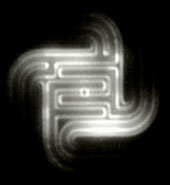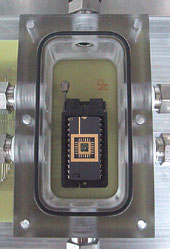| |

Microhotplates crafted of silicon carbide by Boston Microsystems, each consisting of a central plate surrounded by curved tethers. The largest is less than 100 microns (millionths of a meter) across.
Credit: Boston Microsystems, Inc.; National Science Foundation
Select image for larger version
(Size: 86KB), or download a high-resolution TIF version of image (1009KB) |
| |
| |

Infrared image of microhotplate. Central plate is only 43 microns (millionths of a meter) across.
Credit: Boston Microsystems, Inc.; National Science Foundation
Select image for larger version
(Size: 47KB) |
| |
| |

Miniature, polycarbonate laboratory that houses the microhotplates. The hotplate is visible as a minute, gold-colored speck in the center of the chamber.
Credit: Boston Microsystems, Inc.; National Science Foundation
Select image for larger version
(Size: 81KB) |
| |
| |
Larger versions of all images from this document |
| |
 Note About Images Note About Images |
ARLINGTON, Va.—Engineers have created a miniature hotplate that can reach temperatures above 1100°C (2012°F), self-contained within a "laboratory" no bigger than a child's shoe.
The micro-hotplates are only a few dozen microns across (roughly the width of a human hair), yet are capable of serving as substrates, heaters and conductors for thin-film experiments ranging from material analyses to the development of advanced sensors.
Researchers at Boston MicroSystems, Inc. craft the hotplates out of silicon carbide, a robust material that can tolerate extreme heat and reach peak temperature in less than one-thousandth of a second.
Silicon carbide is not only stable at high temperatures, it is also impervious to chemical attack from most materials. As a result, the hotplates can be cleaned by merely burning debris off the surface.
Contained on a microchip, the tiny "labs" reside within a polycarbonate chamber that can endure near-vacuum pressures. Ports on the chamber's sides allow gases to pass through and feed experiments, and because of the chamber's transparency, researchers can observe experiments with a microscope as they progress.
The hotplates also contain an integrated temperature gauge and a pair of electrodes. These components allow researchers to test the electrical properties of various materials that may be deposited onto the hotplates.
Using the stable, thin-film deposition properties and integrated circuitry of the hotplates, researchers are already developing applications such as oxygen and engine emission sensors. The sensor may have several advantages over devices in today's combustion engines, due to the micro-hotplate's chemical stability, small size, rapid response and low power consumption.
The techniques necessary for crafting and optimizing these micro-electro-mechanical systems (MEMS) were developed with support from the National Science Foundation Small Business Innovation Research (SBIR) program and SBIR programs at the Department of Energy, Environmental Protection Agency, and NASA.
Comments from the researchers:
"High-temperature silicon carbide micro-hotplates are new to the research community and may prove to be flexible tools for optics, chemical vapor deposition chambers, micro-reactors and other applications." – Rick Mlcak, Boston MicroSystems
"The micro-hotplate arrays are versatile research tools—the same basic system can adapt to handle such diverse experiments as analyses of heat treatments and the characterization of new thin film materials." – Rick Mlcak, Boston MicroSystems
Comments from NSF:
"The proposed oxygen sensor may find applications in the characterization of automobile emissions and the control of oxidation and reduction reactions in ceramics and metallurgical processing." – Winslow Sargeant, the NSF SBIR program officer who oversees the Boston Microsystems award.
"The exceptionally small size and low power consumption of the micro-hotplate oxygen sensors make them particularly suited for portable instrumentation, monitoring of hazardous environments, sensing of respiration and biological processes, control of oxygen-sensitive industrial processes, and the packaging and monitoring of food." – Winslow Sargeant
|

